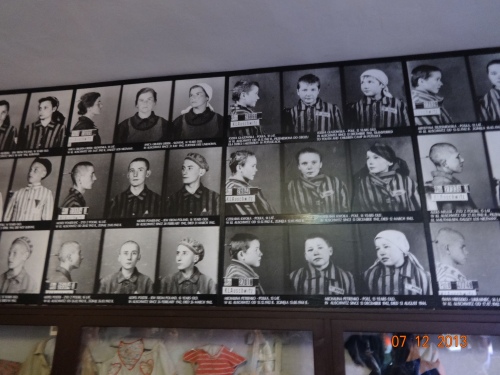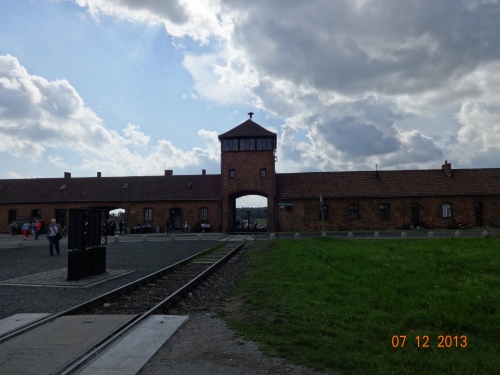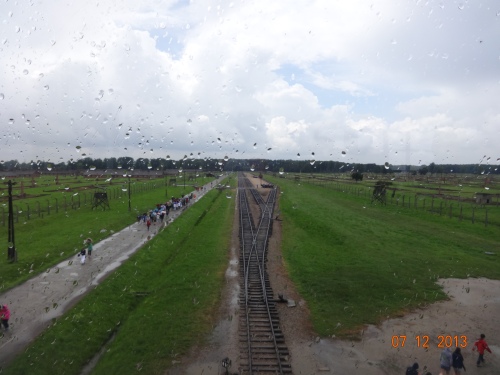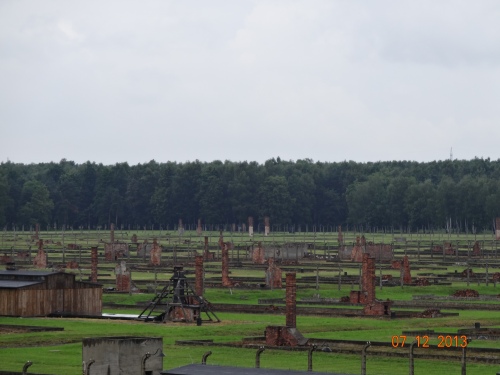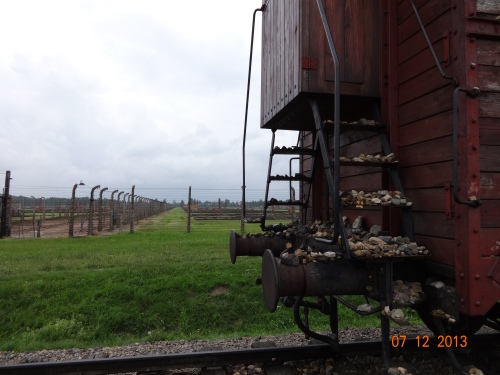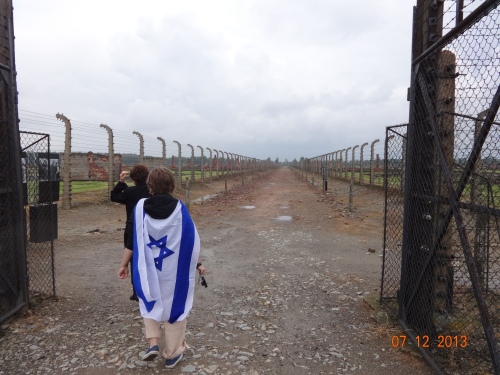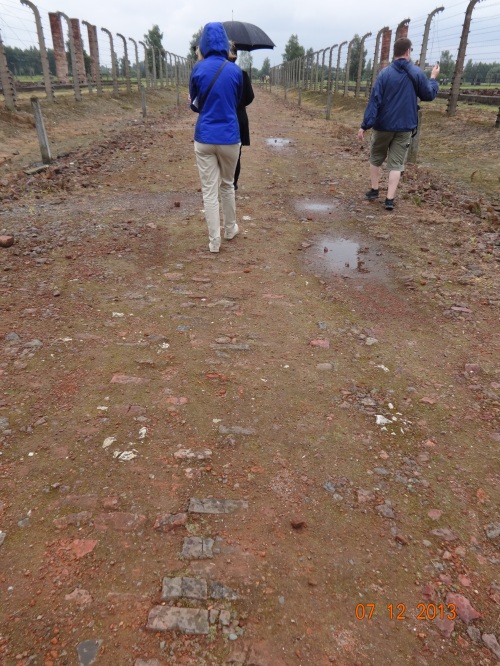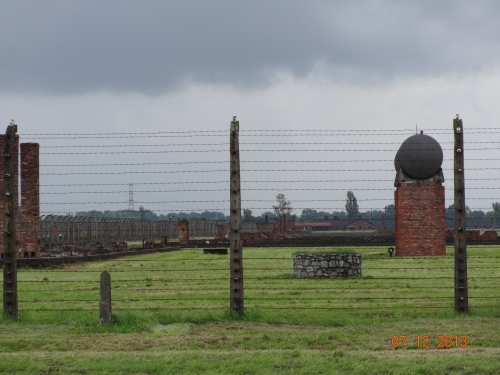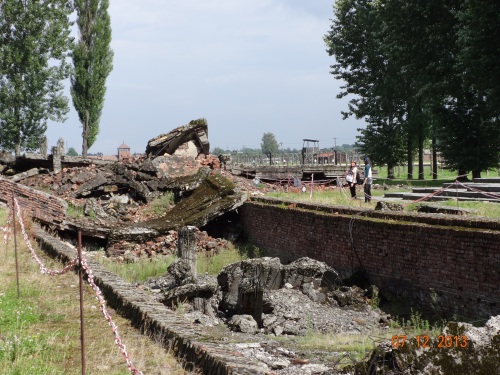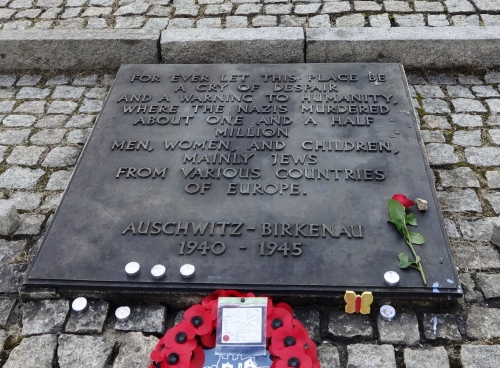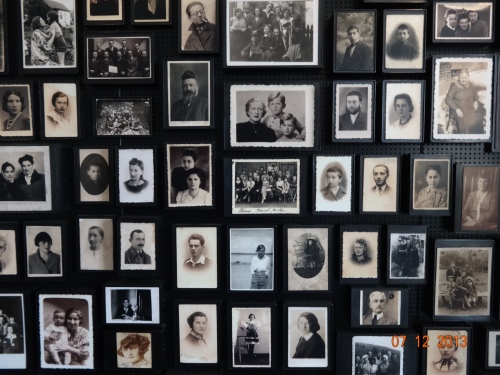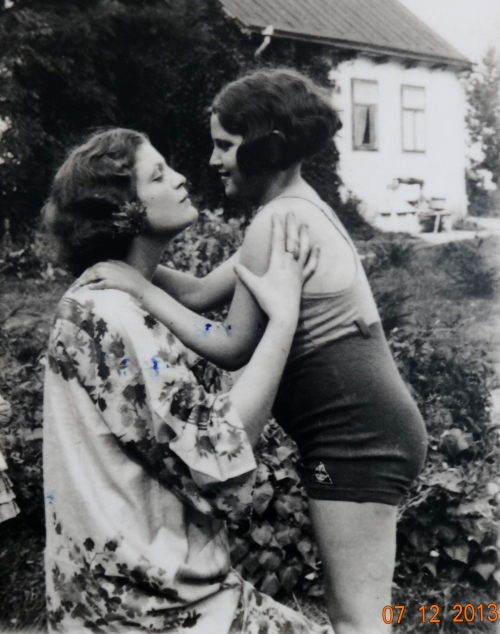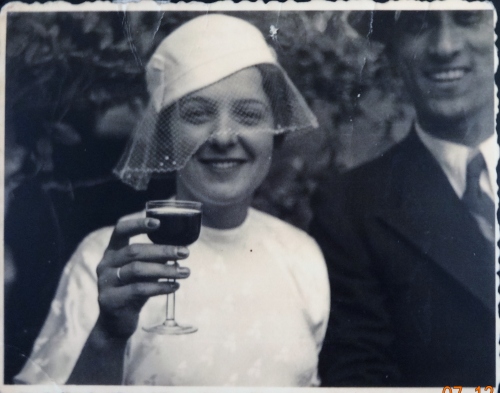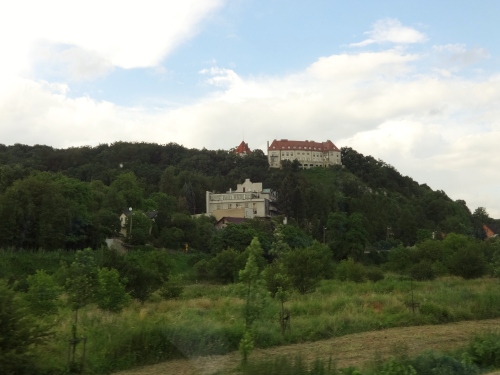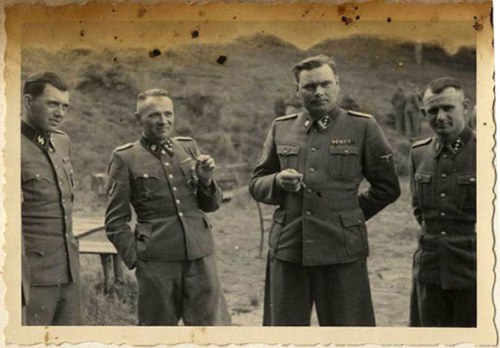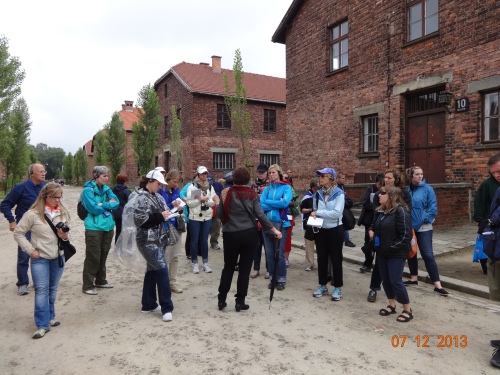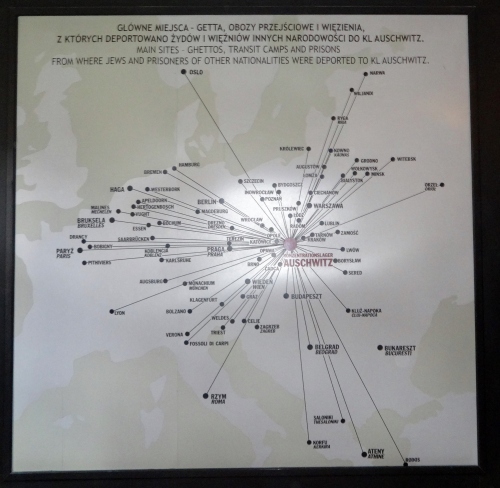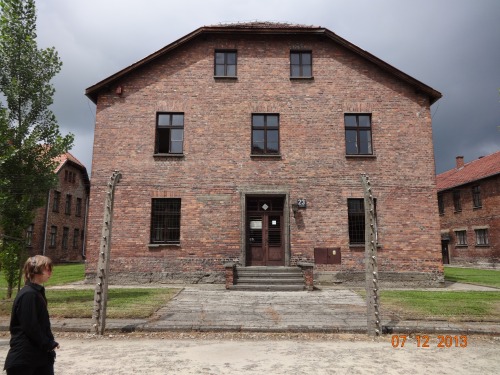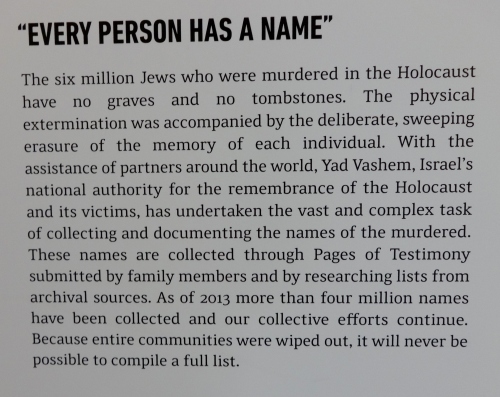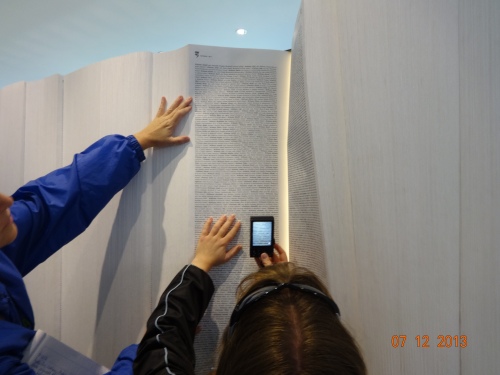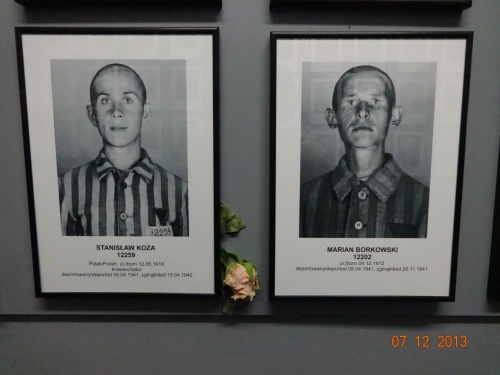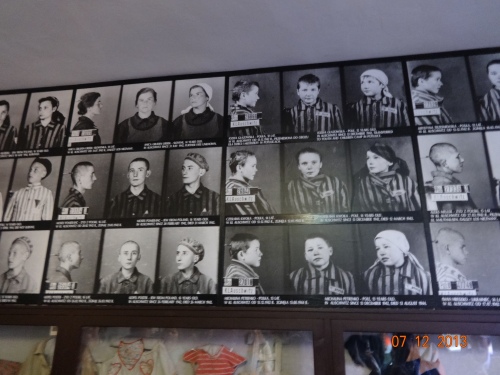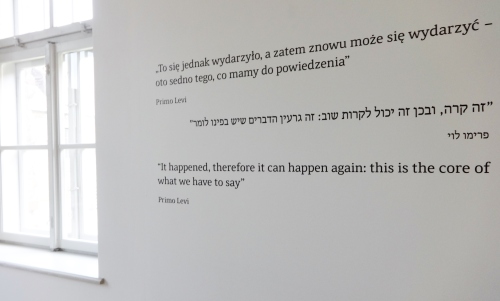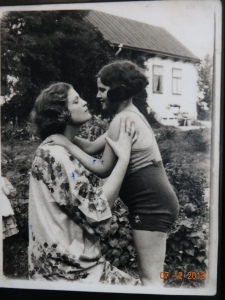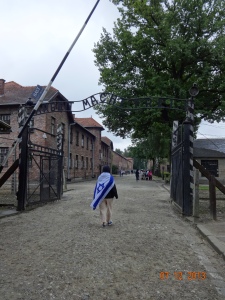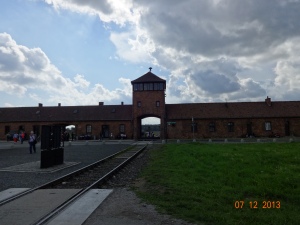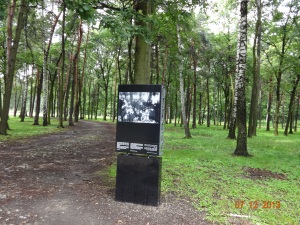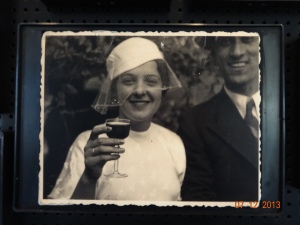This week I introduced what will be a series of posts under the heading of ‘Seventy Years’, marking the 70th anniversary of the close of World War II and discovery of the magnitude of the most horrific crime in the history of the world, the Holocaust.
Today I travel again back to Auschwitz-Birkenau, sharing some of my personal observations and photographs on the anniversary of the liberation by Soviet troops 70 years ago this week.
*****
July 12.
After the tour of Auschwitz I, our teacher travel study group has lunch on the bus in the parking lot, then drive the three kilometers through town to Birkenau.
There it is. The entry tower. The iconic symbol of evil.


Main entrance to Auschwitz-Birkenau . USHMM
We follow the guide up the stairs in the tower. From here we can see the sheer vastness of the camp.


Women’s Barracks. Auschwitz II.
Dozens of long narrow women’s barracks, brick, still stand, albeit some braced with wood on the gable ends to keep them from toppling until they can be re-pointed. A. indicates that historic preservation here is a major concern.

The rest of the camp is many square kilometers of row upon row of foundations and brick chimney stubs, surrounded by the menacing curved and tapered concrete concrete posts dotted with white insulators and strung with miles of parallel lines of barbed wire. In the summer of 1944, when hundreds of thousands of Hungarian families were deported here, the rail lines came right into the camp.

View of the Ramp at Auschwitz-Birkenau Showing the SS Selection of Hungarian Jews, USHMM.

View of the Ramp at Auschwitz-Birkenau Showing the SS Selection of Hungarian Jews, USHMM.
Following the German invasion of Hungary in March 1944, over 400,000 Hungarian Jews were deported and murdered at Auschwitz.

Our guide leads us along the path through the camp that leads to the gas chamber and crematorium. We walk in in silence along the roadway, the only sound the crunching of brick fragments and gravel underfoot.

Selected.


It appears to have been paved with brick, slave labor, though in some spots it is hard to tell anymore. No one speaks, and on and on we walk. Two minutes. Five minutes. Ten minutes. Fifteen minutes. I’ve been on battlefields that are smaller than this site.

Finally we reach the end of the camp where the kitchens stood. A round concrete ring rises out of the earth, maybe 6 feet in diameter. Someone finally speaks and asks A. what it was. A giant flowerpot. She tells us also that they were placed near the entrances of the gas chambers. Flowers at the gas chambers.
We turn left, and keep walking past interpretative signage. It seems like we are walking outside of camp perimeter. But we are not. Beautiful woods appear and we are walking on the edge of the woods with the camp to our left. We stop near another sign and rest for a moment, allowing the others to catch up. Then our guide calls our attention to the photo on the sign, showing Hungarian mothers and children doing the same thing we are doing. Halting and resting. And a short path through the woods will take us to the ruins of the gas chamber/crematorium Number Five.

They waited here. Some days, in the summer of 1944, for hours.
We are resting at the spot they rested at, 20 minutes after walking, immediately after disembarking of overcrowded transports that had been traveling for days. Here they waited, anxiously, as their turn to approach the chamber would come. But the victims of the transport ahead of them had to be removed from the chamber first. Some days in the summer of 1944 these victims were backed up for hours.
I pick up a rock from the path and carry it with me past the ruins. At the ashfield there is more signage and a memorial asking visitors not to walk through the field. I place my stone on the memorial, looking down to watch where I step. But it is probably a futile gesture-this whole place is an ashyard, a graveyard.
“So many Hungarian Jews were killed in the Auschwitz camps during that period that the crematoria were incapable of consuming all the bodies, and open pits for the purpose were dug.”

We turn again, and walk past the remains of crematorium Number Four. To the disinfection center for those selected to be worked to death. Again, a system. Disrobing. Wading through disinfectant. Shower. Uniform thrown at you, mismatched clogs or shoes.
*****
E’s mother spent two years here. Her grandmother and the little ones were selected upon arrival. Her mom’s beloved sister was murdered in the quarry after slipping while carrying a large pot of soup in the ice and snow with three other girls. Today is a hard day. I want to comfort her, to carry her pack for her. I feel helpless. There is nothing I can do.

At the Soviet memorial constructed near the two destroyed gas chamber/crematoria at the end, we have a remembrance ceremony. Kaddish is recited in Hebrew. I read it aloud in English. With tears, E. tells us that she feels her grandmother smiling down on this extraordinary group of dedicated teachers. A lump rises, again. I swallow hard and try to blink back the wetness I feel welling in my eyes. Damn, I almost made it. Glad for the sunglasses, even though there is no sun.




“A Warning to Humanity.”
We light candles, turn our backs, and walk out, which provides another twenty-minute stretch of personal reflection. We have toured the epicenter of evil. We have been here, we try to process-but we just cannot. We need the individuals to speak to us. And like E’s family, they do.

At the close of the disinfection center exhibit there are hundreds of photographs that had been discovered years after the camp was abandoned by the Germans. Pictures of loved ones who perished here.
For me, like the personal home movies of pre-war life for the victims at the exhibit at Auschwitz I, this is what has the most meaning. So I will leave you for now with a few close ups.




 To Life.
To Life.
*****
From National Public Radio:
A Holocaust Survivor, Spared From Gas Chamber By Twist Of Fate
by Soraya Sarhaddi Nelson, International Correspondent, Berlin
January 27, 2015 3:40 PM ET

Jack Mandelbaum, a Holocaust survivor from the Polish city of Gdynia, poses in front of a photograph showing him as a youth. Tobias Schwarz/AFP/Getty Images
Seventy years ago, Soviet soldiers liberated Auschwitz, the most notorious of Nazi concentration camps.
Some 300 Holocaust survivors were at Auschwitz on Tuesday, along with several European presidents and other government officials, to honor at least 1.1 million people who were murdered, 1 million of whom were Jewish.
Among those killed there were Jack Mandelbaum’s mother and brother. The Polish-born Mandelbaum survived, spared at the last minute by an officer of the dreaded SS who yanked the teen away from his family and sent him instead to a forced labor camp.
Last week, Mandelbaum flew from his Naples, Fla., home to Berlin, to help open an exhibit on the children of Auschwitz, and to tell his story.
“I’m a person of action,” he says. “Anger doesn’t get you anyplace. Hate doesn’t get you anyplace.”
In August 1939, as the Nazis were about to invade Poland, Mandelbaum was 13 and living in the Polish port city of Gdynia. Mandelbaum says his father worried that the port would be attacked, so he sent his wife and three children to stay with relatives in the countryside.
He promised to join them six weeks later, but he never arrived. About a year later, he sent them a postcard from the Stutthof concentration camp.
“I guess he didn’t want us to worry about him, so he said he was OK,” Mandelbaum says.
He never saw his father again. His sister later died on a forced march to another concentration camp.
Prisoner 16013
Then, before dawn on June 14, 1942, the SS came for what was left of the family.
“They banged on the door and everyone had to come out in five minutes, and there was a lot of shooting and crying, and people didn’t know what was happening because they had to rush out,” Mandelbaum recalls. “Many people were even in their bed clothes. And we were lined up in the market square, and then we were marched to a local brewery.”
An SS officer there began separating people to the left and to the right. Mandelbaum says he clung to his mother and brother, who were sent to the left. But the SS officer saw in his documents that Mandelbaum had worked as an electrician’s helper.
“He grabbed me and pushed me to the other side,” Mandelbaum says. As for his family, he says, “The people who were to the left were sent to Auschwitz to be gassed. I never saw them again.”
To the Nazis, he became prisoner 16013 and spent the next three years at seven concentration camps. The first was Gross-Rosen, where prisoners worked in a granite quarry.
“There were so many prisoners,” he says. “We were in a big barrack, it had a concrete floor, it had no beds. And we were lined up like herring on the floor, so when one person turned, everybody else had to turn, it was so tight.”
Food was scarce, and the daily meal amounted to a single piece of bread and what Mandelbaum describes as soup made out of grass.
He recalls emaciated prisoners stuffing paper into their mouths to fatten their cheeks so they’d look healthier to the guards assigned to remove the weak for extermination. His own weight eventually dropped to 80 pounds.
But Mandelbaum says he refused to give up hope. He poured what little energy he had into work, hoping it would eventually lead to his release.
Suddenly, Freedom
“We had a good life before the war. I went to a public school, I had good clothes and good food and a nice apartment,” he says. “My dream was to go back to this life and be reunited with my family and my sister and my brother, and that sustained me.”
It also helped that he didn’t know the Nazis were trying to slaughter all Jews, something he says he and other prisoners learned only after liberation.
Their sudden freedom, too, was a complete shock, Mandelbaum says. “We didn’t know anything, only on the morning when we woke up and the Nazi flag wasn’t flying and the guards weren’t there.”
Unlike at Auschwitz, Allied soldiers did not free them, as his camp was in a no man’s land between the fleeing Nazis and advancing Russians. He and a friend from the camp grabbed an abandoned horse-drawn wagon and left as quickly as they could.
“We came across a women’s concentration camp and they were still locked up, so we actually became the ‘liberators’ of the camp,” he says, with a laugh.
Mandelbaum was 17 when the Holocaust ended. He says he returned to Poland several times to see if he could find his family but failed. He did find an uncle living in a hamlet near Munich.
The following year, he immigrated to the United States and settled in Kansas City, Mo., where he married, had four children and became a successful importer of ladies’ handbags. It would be 16 years before he began speaking publicly about the Holocaust, something he says he decided to do after talking to one of his neighbors.
“He asked me what kind of sports did I play in the concentration camp, so all of the sudden it just opened everything up, how little people knew what was going on, and this was when I started to speak in different venues about my experiences,” he says.
That desire to educate people brought Mandelbaum, 87, to Berlin last week. He says it’s sad to see anti-Semitism on the rise in Germany and elsewhere in Europe, but he hopes he and other Holocaust survivors can make a difference.
“You know, when we were in the camps, we would always ask, ‘How can the world stand by and let this happen?’ ” he says. “So it’s a matter of being vigilant, a matter of trying to do as much as you can in order to enlighten people [about] how dangerous it is when you become a bystander.”
http://www.npr.org/2015/01/27/381876276/a-holocaust-survivor-spared-from-auschwitz-at-the-last-second
*****
Read Full Post »











































